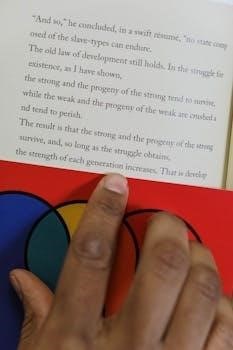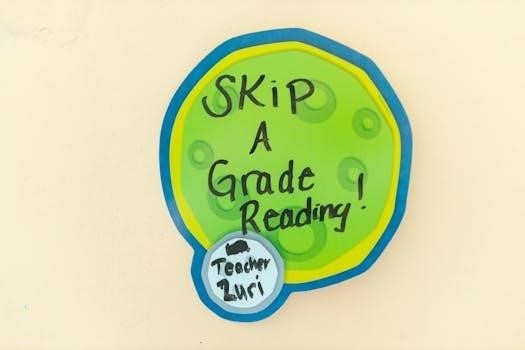Overview of 1st Grade Reading Passages PDF
First grade reading passages in PDF format are designed to enhance young learners’ reading skills. These worksheets typically include leveled stories with colorful images. They focus on understanding main ideas, identifying details, and sequencing events.
Reading comprehension in first grade marks a crucial step in a child’s literacy journey. It involves not just decoding words, but also understanding the meaning behind them. 1st grade reading comprehension passages are specifically designed to introduce young learners to the basic elements of storytelling and informational texts. They serve as a foundation for more complex reading tasks later on, encouraging children to engage with texts actively and develop a lifelong love for reading. Worksheets with passages and questions are an engaging exercise.
Importance of Reading Comprehension in First Grade
Reading comprehension is critically important in first grade as it lays the groundwork for future academic success. It helps children develop crucial skills like understanding main ideas, making inferences, and sequencing events, all vital for learning across different subjects. Comprehension skills enhance vocabulary and improve overall communication abilities. Furthermore, it encourages critical thinking and fosters a love for reading, which are essential for lifelong learning. Reading comprehension activities in first grade set the stage for continued growth and achievement.
Free Printable 1st Grade Reading Passages
Free printable 1st grade reading passages are readily available online. These resources offer engaging stories and comprehension exercises tailored for young learners. They are easily accessible and can be used at home or in the classroom.
Availability of Free PDF Worksheets
Numerous websites offer free PDF worksheets for 1st grade reading comprehension. These resources are easily accessible and downloadable, providing educators and parents with a wealth of materials. The availability of free worksheets allows for convenient practice at home or in the classroom. Many sites provide a variety of passages catering to different reading levels and interests within the first-grade curriculum. These printable PDFs often include engaging content and comprehension questions to assess understanding.
Content of Free Worksheets⁚ Stories and Images
Free 1st grade reading comprehension worksheets commonly feature engaging stories and colorful images to captivate young learners. The stories are often short and tailored to a first-grade reading level. The images complement the text, aiding comprehension and maintaining student interest. These worksheets may include a mix of fiction and non-fiction passages, covering various themes. The combination of stories and images makes learning fun and interactive, encouraging children to develop their reading skills. Worksheets often include comprehension questions.
Skills Developed Through Reading Passages
Reading passages enhance key skills such as understanding main ideas, identifying details, making inferences, and sequencing events. These activities improve reading comprehension, vocabulary, and critical thinking abilities in first-grade students through interactive exercises.
Understanding Main Ideas and Details
First-grade reading comprehension passages are designed to help students grasp the central point of a story or text. Identifying details supports this understanding, enabling children to recall specific information. Worksheets often include questions that prompt students to find key details, strengthening their ability to extract essential information and comprehend the overall message. Recognizing both main ideas and details is crucial for reading proficiency.
Making Inferences and Sequencing Events
Reading comprehension passages for first graders also focus on developing inference skills. Students learn to “read between the lines,” drawing conclusions based on the text. Additionally, sequencing events is a critical skill. Worksheets often present stories where students must identify the correct order of events. These exercises enhance logical thinking and improve comprehension by helping children understand the flow and structure of a narrative, developing crucial analytical abilities.

Types of Reading Passages for 1st Grade
First-grade reading passages include both fiction and non-fiction texts. These passages are designed to improve reading comprehension. They often incorporate phonics-based words and controlled vocabulary to aid in reading fluency and skill development.
Fiction and Non-Fiction Texts
First-grade reading passages commonly feature both fiction and non-fiction texts to expose young learners to diverse content. Fiction stories often include engaging characters and imaginative plots designed to capture children’s interest and foster a love for reading. Conversely, non-fiction texts introduce real-world topics, helping students develop their understanding of the world around them while enhancing their comprehension skills through factual information and vocabulary.
Phonics-Based and Vocabulary-Controlled Passages
First-grade reading passages frequently incorporate phonics-based and vocabulary-controlled content to aid early literacy development; Phonics-based passages emphasize decoding skills by highlighting specific sound-letter relationships, enabling students to sound out words effectively; Vocabulary-controlled passages use carefully selected words appropriate for first-grade level, ensuring that the text is accessible and comprehensible. This approach supports reading fluency and builds confidence as children encounter familiar words and phonetic patterns.
Using Reading Passages in the Classroom
Reading passages for first grade can easily be integrated with the curriculum to improve students’ reading comprehension. Differentiated reading passages allow teachers to meet the needs of all students.
Integration with Curriculum
Integrating reading passages into the first-grade curriculum enhances literacy skills. Worksheets support key areas like understanding main ideas and sequencing events. Many schools include these comprehension passages in their curriculum, using them to build reading proficiency. These exercises are interactive and easy to complete, aligning perfectly with first-grade learning objectives. By incorporating these passages, teachers can effectively reinforce reading skills and comprehension.
Differentiated Reading Passages
Differentiated reading passages cater to varied reading levels in first grade. These passages come leveled, often based on scales like the Fleisch-Kincaid Grade Level. Such differentiation ensures each student receives materials suited to their abilities. Teachers can provide reading material at the right level for students. Passages can support advanced kindergartners or older students. Controlled vocabulary and phonetic-based words are included for targeted practice. This approach helps accommodate individual learning needs.

Assessing Reading Comprehension
Assessing reading comprehension involves using comprehension questions after passages. These questions evaluate understanding of the text. Fluency goals are often set for first grade to measure reading speed and accuracy.
Comprehension Questions After Passages
Following each reading passage, comprehension questions are included to assess a student’s understanding of the material. These questions often target key areas such as identifying the main idea, recalling specific details, and making inferences based on the text. The questions help teachers evaluate how well students are grasping the content and provide valuable insights into their reading comprehension skills. These questions serve as a tool for reinforcing learning.
Fluency Goals for First Grade
Fluency goals for first grade often involve improving a student’s reading speed and accuracy. The aim is to have students read with expression and ease. According to AIMSweb, a common end-of-year fluency goal is approximately per minute. Reading passages, even if longer, can aid in achieving this, as repeated readings help improve fluency. The expectation isn’t to read the whole passage initially, but to show improvement with each attempt.
Additional Resources for 1st Grade Reading
To supplement reading passages, alphabet tracing books and handwriting practice materials are beneficial. Math resources tailored for first grade can also enhance overall learning and provide a well-rounded educational experience.
Alphabet Tracing and Handwriting Books
Alphabet tracing books are valuable resources for young learners, offering structured practice in letter formation. These books typically cover tracing letters from A to Z, helping children develop fine motor skills and letter recognition. Supplementing reading comprehension activities with handwriting exercises reinforces literacy skills. Handwriting books for kindergarten and first grade provide additional practice to improve penmanship and writing fluency. These resources support early literacy development by connecting letter recognition with writing proficiency, creating a strong foundation for future reading success.
Math Resources for First Grade
First-grade math resources are essential for building a strong foundation in numerical literacy. These resources often include worksheets and activities designed to reinforce basic math concepts such as addition, subtraction, and number sense. Integrating math resources alongside reading comprehension activities provides a well-rounded educational experience. Worksheets for first grade math often cover topics like counting, number patterns, and simple word problems. By combining math and reading, educators can support holistic development, ensuring students excel in both literacy and numeracy.
Where to Find 1st Grade Reading Passages
You can find 1st grade reading passages on online educational websites. Teachers Pay Teachers is also a valuable resource. These platforms offer a variety of free and paid materials.
Online Educational Resource Websites
Several online educational resource websites offer first-grade reading passages in PDF format. These websites often provide a range of free worksheets and activities designed to improve reading comprehension skills. K12Reader, for example, offers free reading worksheets suitable for various curricula. These resources can be accessed globally, providing engaging stories and comprehension questions tailored for first graders. University of Florida Literacy Institute (UFLI) is also a great place to find resources.
Teachers Pay Teachers
Teachers Pay Teachers (TpT) is a marketplace where educators can buy and sell original educational resources, including first-grade reading passages in PDF format. This platform offers a vast selection of materials, ranging from fiction and non-fiction texts to comprehension exercises and phonics-based worksheets. Many resources are available for free, while others can be purchased to support teachers in creating engaging and effective reading lessons. It’s a trusted platform for millions of educators.

Tips for Encouraging Reading in 1st Graders
Encouraging first graders to read involves making it fun and focusing on understanding the story. Help them grasp the main idea, and use interactive activities to keep them engaged, fostering a love for reading.
Focusing on Understanding the Story
When introducing reading to first graders, prioritize comprehension over minor details. Help them understand the central idea of the story first. As you read through a passage, ask questions like, “What is happening here?” or “Who are the main characters?” to ensure they grasp the narrative. Encourage them to retell the story in their own words. Focusing on understanding the story fosters enjoyment and deeper engagement with the text.
Making Reading Fun and Interactive
To encourage reading in first graders, make the experience fun and interactive. Use colorful worksheets with engaging stories and images. Incorporate games to improve reading comprehension. Ask comprehension questions after each passage to assess understanding. Bella and James are playing a rhyming game. Create activities where children can act out scenes from the story or draw their favorite characters. Remember, a positive reading experience fosters a lifelong love for books.
Benefits of Using Reading Comprehension Worksheets
Reading comprehension worksheets for first grade improve reading skills through focused practice. They also enhance vocabulary by introducing new words in context. These worksheets help children understand the story better.
Improved Reading Skills
The primary benefit of using reading comprehension worksheets is the improvement of reading skills. Regular practice with these passages helps first graders develop fluency and accuracy. Worksheets targeted at their grade level reinforces their ability to decode words and understand sentence structure. Repeated reading of passages enhances familiarity and builds confidence. Engaging with comprehension questions after reading ensures active engagement and deeper understanding. This consistent practice leads to significant gains in reading proficiency over time.
Enhanced Vocabulary
Reading comprehension worksheets expose first graders to a wider range of vocabulary. Encountering new words in context helps them understand their meanings. Worksheets often include vocabulary exercises, reinforcing word recognition and usage. As children read more, they naturally learn new words and phrases. The phonetic-based words included in these passages further aid in decoding and understanding new terms. This expanded vocabulary enhances not only their reading comprehension but also their overall communication skills. A richer vocabulary supports writing and speaking abilities as well.

Adapting Reading Passages for Different Levels
Reading passages can be modified to suit different reading abilities. Complexity can be adjusted for advanced or struggling readers. These passages also support guided reading by providing leveled material, ensuring appropriate challenges for all students.
Adjusting Complexity for Advanced or Struggling Readers
To accommodate diverse learning needs, first grade reading passages can be adapted. For advanced readers, increase sentence length, vocabulary, and complexity of plot. For struggling readers, simplify sentences, use phonetic-based words, and focus on core comprehension. These modifications ensure all students engage with the material effectively. Controlled vocabulary and phonetic awareness are essential for supporting struggling readers. Advanced students benefit from more challenging content.
Using Passages for Guided Reading Levels
First grade reading passages are invaluable for guided reading sessions, enabling targeted instruction based on individual reading levels. These passages are often leveled (A-P) with controlled vocabulary and phonetic patterns to match specific needs. Teachers can select passages aligned with each student’s abilities to ensure comprehension and fluency development. Guided reading allows for focused support, enabling students to progress at their own pace. Comprehension questions help assess understanding.

